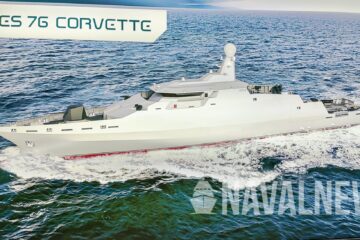The Philippines has commenced training procedures for its personnel in the Philippine Navy tasked to keep watch over the country’s territory on how to operate its South Korean-made corvettes that are set to arrive in the next two to three years, a navy official said Tuesday.
Crew members tasked to man the two guided missile corvettes would be deployed to South Korea to train with the “original equipment manufacturers at the HD Hyundai Heavy Industries (HHI) shipyard in Ulsan, South Korea,” navy spokesperson Commander John Percie Alcos told reporters in a news briefing.
“The first corvette will be coming in during the second semester of next year,” Alcos said, adding a second is expected to be delivered in 2026.
In December 2021, Manila, represented by Department of National Defense, signed a deal with HHI worth PHP 28-billion for the acquisition of two brand-new corvettes capable of anti-ship, anti-submarine, and anti-air warfare missions.

Equipped with a vertical launching system and AESA radar system, the 3,200 ton class corvettes have a length of 118.4 m, a width of 14.9 m, a cruising speed of 15 knots (about 28 km/h), and a range of 4,500 nautical miles (8,330 km).
“Six months ago, the Philippine Navy began preparing for that already. We’ve been training people, we’ve been organizing them and to include the procurement of necessary equipment for them to perform effectively when the new acquisitions arrive,”
“The Navy has also started the procurement of the “necessary equipment” to allow personnel to perform effectively when these new acquisitions arrive. But warfare-wise, warfighting-wise they are already undergoing training,” Alcos added, citing the upcoming vessels will be more heavily armed than the Jose Rizal-class frigates.
Alcos revelation about the Corvettes came days after the latest harassment perpetrated by Beijing’s coast guard against Manila’s routine resupply in Ayungin Shoal that left four Filipino crew members injured, including a senior Philippine Navy official.
The National Task Force for the West Philippine Sea reported that China Coast Guard ships used water cannons to block Philippine vessels taking supplies to Manila’s military outpost at Ayungin (Second Thomas) Shoal in the West Philippine Sea, Manila’s name for South China Sea waters that lie within its EEZ.
Asked for comment, political analyst Sherwin Ona, associate Professor at the Department of Political Science and Development Studies of De La Salle University, said the latest incident does not require the activation of the Mutual Defense Treaty (MDT) between Philippines and the United States since the vessels involved were civilian ships.
Signed in 1951, the MDT calls on both countries to aid each other in times of aggression by an external power. The Pentagon previously said it was prepared to assist Manila if it invoked the treaty amid threats from other nations.
“Framing of conflict is so far within the gray zone approach of the People’s Republic of China. I think Beijing is conscious of this and will avoid a full scale naval confrontation with the Philippines and US,” he said.
“I think the Philippines should be concerned about the possible escalation by the PRC. Now that Beijing has published a report about the oil deposits in the SCS and given its domestic economic woes, we can expect that it will be more aggressive in its actions in the West Philippine Sea,” he added.
China has competing claims in the South China Sea with the Philippines, Malaysia, Brunei and Vietnam.
In 2016, a U.N. arbitration court ruled in favor of the Philippines, saying that China’s historical claims to the sea region as delineated then in Chinese maps by a nine-dash line (now a 10-dash line) were invalid. But Beijing rejected the ruling and has since insisted that it has jurisdiction over all areas within that boundary.
Back in 2012, Manila took Beijing to court after alleging that Chinese naval vessels obstructed the Philippines’ entry to Scarborough Shoal, which has since remained under China’s administrative control.






